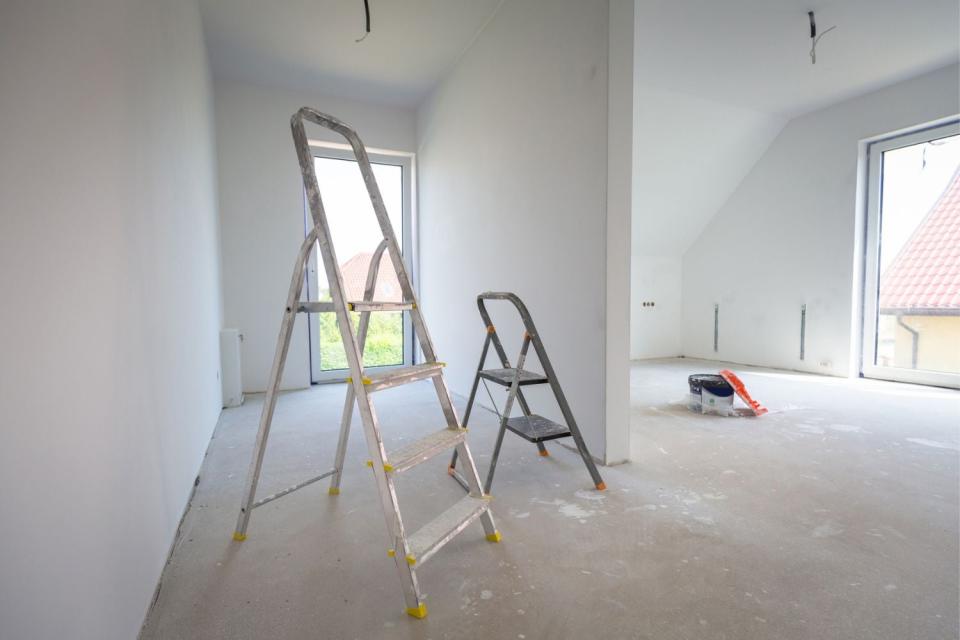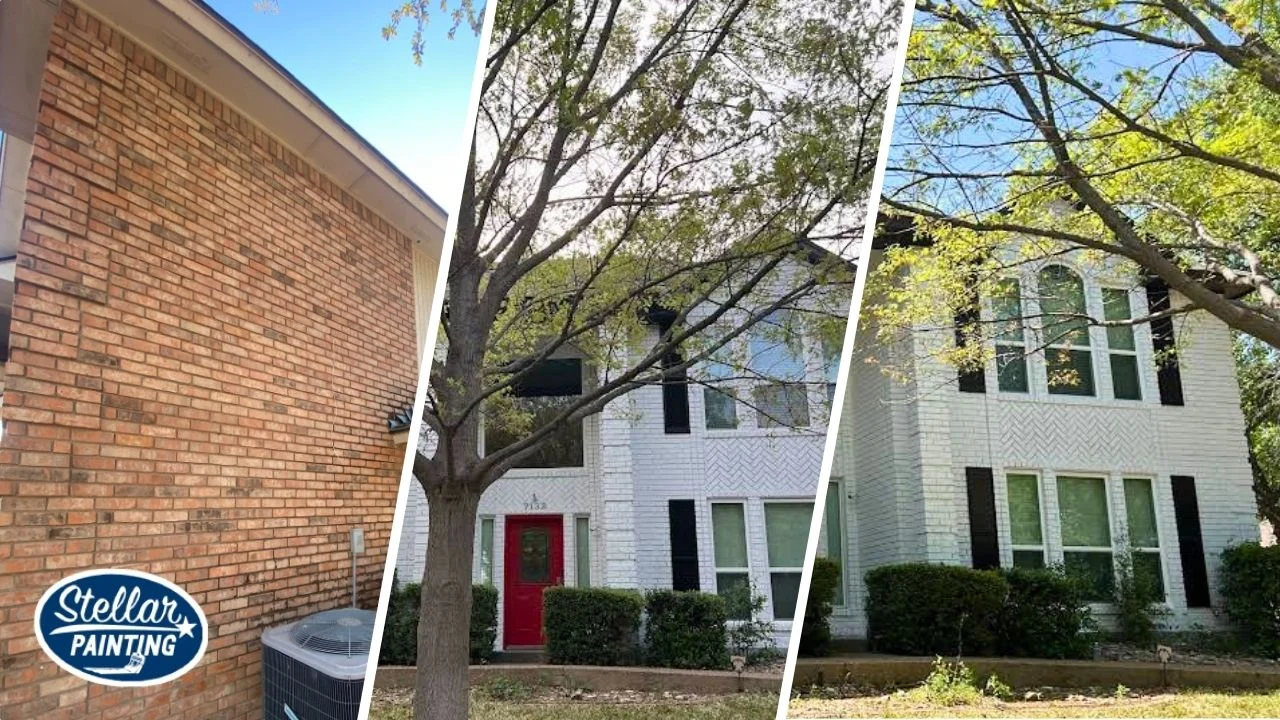Highlights
-
The cost to paint a ceiling averages $150 to 550, though the average cost is about $250.
-
Homeowners anticipating ceiling painting costs will need to consider factors such as ceiling size and height, type of ceiling and paint, prep work, labor, supplies and materials, minimum fees, and ceiling repairs.
-
Homeowners who choose to paint their ceiling may enjoy the benefits of a more aesthetically pleasing environment, a repaired ceiling, and more interest from potential home buyers.
-
Professional painters have the equipment and skills to tackle a back-bending paint job, which saves homeowners from the physically demanding labor themselves.
Painting a ceiling can be a transformative home improvement project, giving the space a fresh and vibrant look. According to Angi and HomeAdvisor, the cost to paint a ceiling varies, but homeowners can expect to pay between $150 and $350, with the national average around $250.
Several factors can influence the cost of painting a ceiling. Larger ceilings naturally require more paint and labor, which increases the overall cost. The height and complexity of the ceiling can also impact the price, with vaulted or textured ceilings often requiring more time and effort.
Labor costs are a significant portion of the total expense, yet the best house painters can ensure a smooth, even finish, which saves homeowners the hassle of tackling the project on their own. The average labor cost to paint a ceiling can range from $25 to $75 per hour, depending on the complexity of the job and the location.
For those looking to add some flair to their ceilings, numerous ceiling paint ideas and ceiling paint colors exist, allowing homeowners to customize the look of their space. Whether a homeowner is painting a drop ceiling, a bathroom ceiling, or a porch ceiling, the key is preparation and technique. By following tips for painting a ceiling, such as starting with a primer and using the right tools, homeowners can achieve a professional finish. Following expert advice on how to paint a ceiling or hiring a professional ceiling painter can ensure a beautiful and long-lasting result.
Photo: depositphotos.com
Factors in Calculating the Cost to Paint a Ceiling
Calculating the cost to paint a ceiling involves several key factors, with the national average of $250 serving as a useful starting point. It’s important to recognize that local averages can vary significantly due to factors such as local labor rates and material costs. Homeowners will benefit from considering their project against the primary factors that influence the cost to paint a ceiling.
Ceiling Size
The size of the ceiling is one of the most important factors affecting the price. Larger ceilings require more paint, labor, and time to complete the project. As a result, homeowners can expect the cost to increase proportionally with the square footage of the ceiling. For example, the cost to paint a standard 10-foot by 10-foot ceiling will be considerably lower than the cost to paint a vaulted ceiling in a more spacious living area.
The cost to paint a ceiling per square foot typically ranges from $0.50 to $5, while painting the ceiling in one room will cost $1 per square foot. Professional painters often charge a higher per-square-foot rate for smaller projects because they need to factor in overhead expenses such as fuel, insurance, travel, and the various supplies required beyond paint, including equipment such as ladders, rollers, edgers, and painter’s tape.
Ceiling Height
Taller ceilings require more labor and materials, which can affect the overall expense of the project. The most obvious impact is on the amount of paint needed if the ceiling is vaulted, which means there’s more square footage to paint.
Typically, taller ceilings cost more due to the need for taller ladders or even scaffolding. There’s also more risk to the ceiling painter the higher they have to climb. Because painting a high ceiling can be more time-consuming and physically demanding for professional painters, it generally costs more than painting walls.
Ceiling Type
Different ceiling types come with their own unique challenges, which can influence the overall cost of the project. For example, ceilings with textured finishes, such as popcorn or stipple, are more time-consuming to paint than smooth ceilings. The texture can make it challenging to achieve an even coat of paint, requiring additional effort and multiple coats.
Vaulted and cathedral ceilings add architectural interest to a space but can be more complex to paint. These ceilings often have varying angles and heights, making it necessary for painters to use scaffolding to reach all areas. Drop ceilings, commonly found in commercial spaces and basements, may be less expensive than other types, since the tiles can be easily removed for painting. Knowing the average cost to paint a ceiling can give homeowners an idea of how much to budget for their painting project.
|
Type of Ceiling |
Average Cost Range (Materials and Labor) |
|
Ceiling grid, or drop tiles |
$1 to $3 per square foot |
|
Exposed basement ceiling |
$2 to $6 per square foot |
|
Popcorn ceiling |
$1 to $3 per square foot |
|
Smooth, flat ceiling |
$1 to $3 per square foot |
|
Tongue-and-groove ceiling |
$1.50 to $5 per square foot |
Ceiling Location
The location of the ceiling within a home can have a significant impact on the cost to paint it. This can affect accessibility, preparation, and other factors that influence the overall cost. An average ceiling in a well-lit room may be easily accessible with a standard-size ladder and equipment, while ceilings in tight or confined spaces, such as narrow hallways or small bathrooms, may require specialized equipment or more labor-intensive methods.
The presence of lights, ceiling fans, or other fixtures can also complicate the painting process. These fixtures often need to be removed or carefully worked around, which can increase the time and labor required for the job.
Additionally, some ceiling locations may require different levels of preparation. For example, a bathroom ceiling may have moisture issues that need to be addressed before painting, while a bedroom ceiling may require only standard cleaning and priming. Painting a porch ceiling may require exterior paint with weather-resistant properties, while an indoor ceiling will likely need standard interior paint.
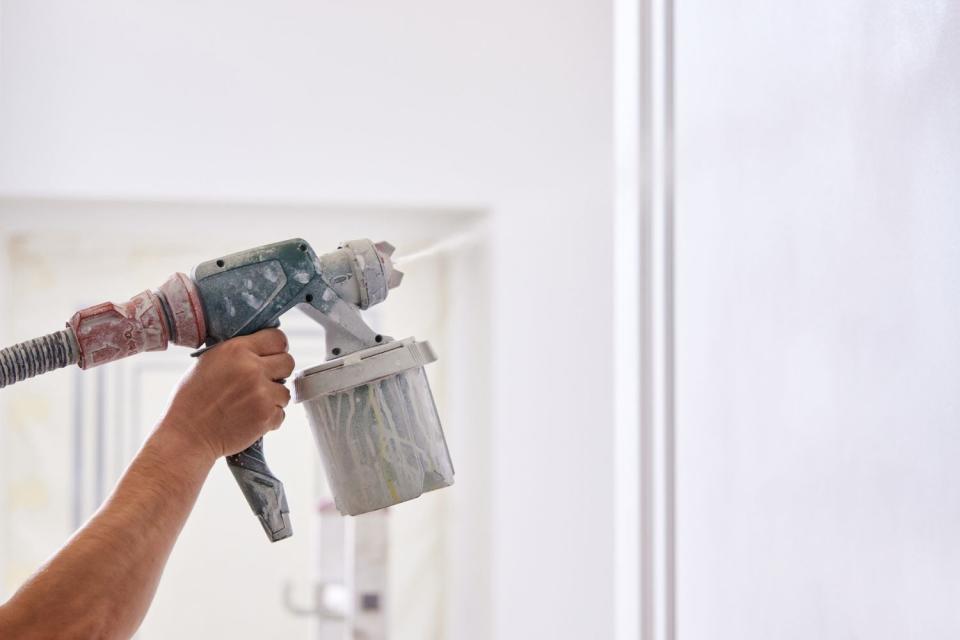
Photo: depositphotos.com
Paint Type
Common considerations when homeowners are choosing the type of paint can include the immediate material cost but also durability, coverage, and long-term maintenance. The cost of ceiling paint ranges from $20 to $60 per gallon, and one gallon will typically cover between 350 and 400 square feet. The cost of the paint itself varies depending on its type and quality. High-quality paints tend to be more expensive per gallon than standard and lower-grade options. The benefit is that premium paints usually offer better coverage and durability, potentially reducing the need for frequent repainting.
Some paints are formulated to cover imperfections and stains more effectively, reducing the need for additional coats, while others may require multiple coats to achieve a satisfactory finish. Understanding the coverage of the paint is important for an accurate cost estimate. Certain ceiling surfaces, such as those in bathrooms, may benefit from specialized paint types designed to resist mold and mildew growth. Ceiling paint for a bathroom is formulated to withstand the conditions of these spaces and often comes at a higher cost than standard paint costs.
For those with specific design preferences, it’s important to understand that different finishes, like matte, eggshell, and semi-gloss, have varying price points. Environmentally friendly or low-VOC (volatile organic compound) paints are increasingly popular choices. These paints may be slightly more expensive than traditional options but offer the benefit of reduced environmental impact and improved indoor air quality.
|
Type of Paint |
Average Cost Range |
|
Flat ceiling paint |
$8 to $20 per gallon |
|
Primer |
$12 to $20 per gallon |
|
Stain-killing paint |
$24 to $36 per gallon |
|
Tinted interior paint in matte, eggshell, or semi-gloss |
$20 to $55 per gallon |
Prep Work
Proper preparation ensures a smooth and long-lasting finish. To achieve that success, painters follow specific tasks that can influence both material and labor costs. The initial condition of the ceiling significantly impacts the cost. If the ceiling has imperfections, stains, or damage, these issues must be addressed before painting.
Repairing cracks, filling holes, and knowing who to call for a water leak all require additional time and materials, which will increase labor and material costs. Cleaning the ceiling thoroughly before painting is essential to ensure proper paint adhesion. Depending on the location and condition of the ceiling, cleaning may involve washing, scrubbing, or using specialized cleaning products.
Properly priming the ceiling is an important step to get an even and durable finish. Primer helps the paint adhere better and can prevent issues like paint peeling or discoloration. The cost of primer and the labor required will need to be factored into the overall estimate.
Protecting the surrounding area from paint splatters or drips is also important, especially when homeowners are painting a ceiling. This may involve covering furniture, floors, and walls with drop cloths or plastic sheeting and using painter’s tape to protect fixtures and edges. Other types of prep work can include sanding and smoothing as well as treating to address moisture issues or mold prevention. Depending on the condition and color of the ceiling, multiple coats of paint may be needed for adequate coverage.
Paint and Supplies
The choice of paint and supplies directly influences the quality of the finish, the ease of application, and the longevity of the paint job. High-quality paints are more expensive than standard paint, but they typically provide better coverage and a smoother finish.
The sheen of the paint can also influence the cost, which means matte or flat finishes are less expensive than semi-gloss or high-gloss paints. Darker or more vibrant colors may require additional coats to achieve full coverage. Depending on the condition of the ceiling and the type of paint used, a primer may be necessary. The cost of primer, as well as the labor required for priming, will need to be factored into the overall cost of the project.
Various supplies are necessary for a ceiling painting project, including brushes, rollers, extension poles, drop cloths, painter’s tape, paint trays, and more. Different ceiling types or locations may require specialized tools or equipment, which can affect the supply cost. For a DIY project, homeowners can spend between $100 and $200 on supplies. If a ladder is needed, that can increase the cost by $200 to $400.
Labor
Labor is often the most significant factor when homeowners are calculating the cost to paint a ceiling. Many professional painters charge between $25 and $75 per hour. The expertise, efficiency, and time spent by professional painters have a profound impact on the overall expense of the project.
Professional painters possess the skill to achieve a flawless paint finish. Their knowledge of techniques, tools, and paint application ensures that the ceiling looks its best. The cost of hiring experienced painters reflects their expertise and ability to deliver high-quality results, and hiring a pro just might be the easiest way to paint a ceiling.
Geographic Location
The cost of labor, materials, and even the demand for painting services can vary significantly from one region to another. Different locations and cities have varying costs of living, which directly influence the labor cost to paint a ceiling by a professional painter.
The cost of paint, supplies, and materials can also fluctuate based on location. Factors such as transportation costs, taxes, and regional pricing trends can lead to variations in the cost of materials. Certain materials may be more readily available and affordable in some regions than in others.
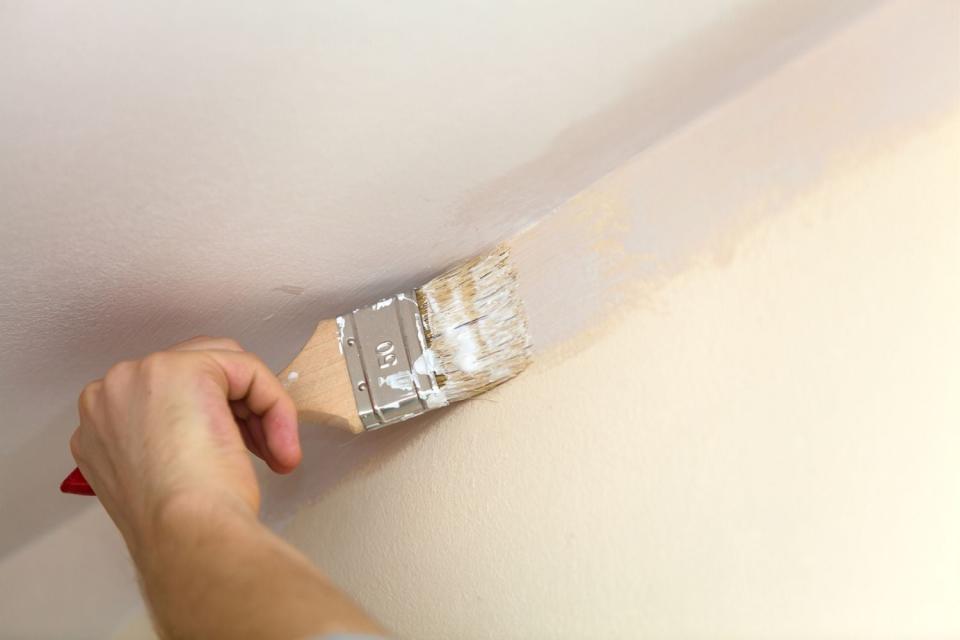
Photo: depositphotos.com
Additional Costs and Considerations
While the national average of $250 is a helpful starting point, calculating the overall cost to paint a ceiling involves careful consideration of additional factors. These can include trim or crown molding, ceiling repairs, minimum fees, electrical work, mold or mildew removal, and ceiling customizations.
Understanding these factors and obtaining estimates from local professional painters can help homeowners budget accurately for their ceiling painting project. Calculating the average cost to paint a room and a ceiling depends on the total square footage and any additional factors that can increase the price.
Trim or Crown Molding
The presence of trim or crown molding can add to the cost of painting a ceiling. These architectural elements, while enhancing the aesthetics of a room, introduce additional complexities and considerations that can impact the overall expense of a ceiling painting project. When estimating the cost, painters take into account not just the ceiling itself but also factors such as trim or molding. More surface area requires more paint, labor, and preparation, not to mention more time, since painting trim and molding requires careful work. These elements often have intricate designs, bevels, or decorative features that require a steady hand to achieve a professional finish.
To make sure the paint goes only where it’s intended, painters need to protect surrounding surfaces, such as walls, floors, fixtures, and adjacent trim. The type of paint used for trim or crown molding may differ from the type used on the ceiling. Professionals hired to paint a ceiling will typically charge an extra $0.50 to $1.50 per square foot to paint crown molding.
Ceiling Repairs
Before a coat of fresh paint is applied, it’s important to address any existing damage, imperfections, or issues on the surface of the ceiling. Ceiling repair costs range from $440 to $1,500, and the cost of materials needed for ceiling repairs will increase the total cost. Common repair materials include joint compound for patching holes and cracks, sandpaper for smoothing surfaces, and primer for sealing repaired areas. The type and quantity of repair materials depend on the extent of the damage.
Repairing a damaged ceiling takes time and effort. Labor costs increase as painters spend additional hours patching holes, smoothing rough areas, and ensuring that the ceiling is in good condition for painting. Complex repairs or extensive damage requires more labor. In some cases, there may be multiple repair areas on the ceiling that need attention. If the repaired areas need to match the existing texture of the ceiling, additional steps or techniques and materials will be required, such as specialized texture sprays. Knowing how to hire the best painting and drywall repair professionals can help homeowners achieve a texture that matches the original ceiling seamlessly.
Minimum Fees
Project minimum fees are charged by some painting contractors to make sure that a project meets a certain minimum cost threshold, usually between $200 and $300. These fees are typically applied to smaller or less extensive painting projects. When homeowners are painting a single ceiling or a small room, the total cost of the project may fall below the contractor’s minimum fee. In some cases, the painting contractor may add the fee to their labor or material costs to meet the fee threshold.
It’s important for homeowners to be aware of any project minimum fee before hiring a professional painter. To avoid these fees, homeowners may choose to bundle painting projects together, such as painting multiple rooms or ceilings at once. This can help them meet the contractor’s fee requirement and potentially save money in the long run.
Electrical Work
Electrical work can add to the cost of painting a ceiling, especially if there are electrical fixtures, wiring, or changes that need attention in conjunction with the painting project. If there are light fixtures, ceiling fans, or other electrical fixtures attached to the ceiling, they may need to be removed before painting. This ensures that the ceiling surface is fully accessible for painting.
In some cases, electrical wiring may run through or along the ceiling. When the ceiling is being painted, care must be taken to avoid damaging or disturbing the wiring. Electricians may need to access the wiring and make any adjustments or reroute it to ensure safety and compliance with electrical codes. Some homeowners may take the opportunity to update or replace ceiling fixtures during a ceiling painting project. Ceiling fan installation costs or other light fixture installation costs can increase the total cost but will improve the appearance of the room.
Mold or Mildew Removal
Mold or mildew removal can significantly add to the overall cost to paint a ceiling, primarily because it involves specialized cleaning, treatment, and potential repairs. The first step in dealing with mold or mildew is to conduct a thorough, professional inspection to assess the problem.
The actual removal process includes cleaning or removing the affected areas to eliminate mold or mildew growth. It’s important for homeowners to keep in mind that simply painting over mold is just hiding the problem without dealing with the source of the issue. Depending on the severity of the toxic growth, removing the mold or mildew can be labor-intensive and may require specific cleaning solutions or equipment.
In some cases, mold on the ceiling may have affected the integrity of the surface, leading to structural or cosmetic issues. Repairing any damage is another expense that will add to the overall project cost. After the mold or mildew is removed, the ceiling may need to be treated to prevent future growth.
Ceiling Customizations
Ceiling customizations, such as unique designs, patterns, or decorative finishes, can add to the cost of painting a ceiling due to the additional time, materials, and expertise required to achieve these specialized looks. Adding texture to a bedroom or living room ceiling costs from $130 to $440 on average.
Elaborate ceiling customizations often involve intricate designs or patterns, and the complexity of the design can significantly increase the labor time needed to complete the project. Hand-painting, stenciling, adding faux finishes, and including any other detail work can add to both labor and material costs. Homeowners considering customized ceilings to achieve a unique and personalized look will want to budget for these additional expenses.
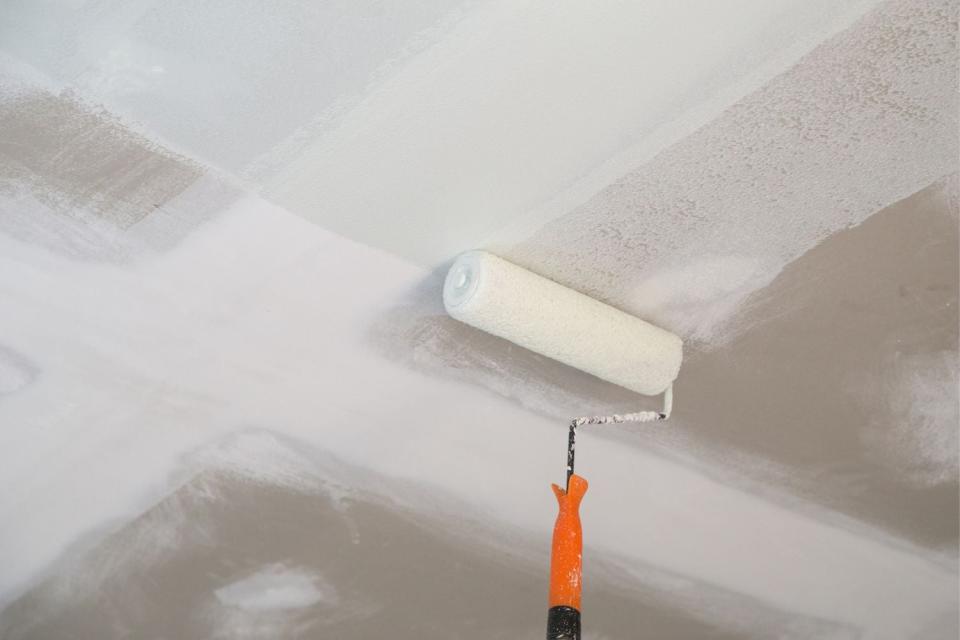
Photo: depositphotos.com
Cost to Paint a Ceiling by Type of Ceiling
The cost to paint a ceiling can vary significantly based on the type of ceiling involved. Different ceiling types come with unique characteristics and considerations that influence the overall price of the painting project. Some of the most common types of ceilings are ceiling grid (also called drop tiles), exposed basement, popcorn, smooth, and tongue and groove.
Ceiling Grid, or Drop Tiles
Drop ceilings, also known as ceiling grids or drop tiles, consist of a metal grid framework with removable ceiling tiles and are commonly found in residential basements. Painting a drop ceiling typically involves painting both the grid framework and the individual tiles. The grid may require more labor due to its complexity, and the cost can vary based on the number of tiles and the material (acoustic tile or fiberglass). The cost for painting this type of ceiling can range from $1 to $3 per square foot.
Exposed Basement Ceiling
Exposed basement ceilings are often unfinished and consist of exposed joists, ductwork, and other structural elements. Painting an exposed basement ceiling can be more straightforward than other ceiling painting projects, since there are no tiles or intricate details. The cost may depend on the number of structural elements to be painted and their accessibility, but the average can run from $1 to $6 per square foot for exposed basement ceilings.
Popcorn Ceiling
Popcorn ceilings, characterized by their textured surface, have lost much of their appeal since they were popularized in the mid-20th century. Removing or smoothing popcorn texture before painting can be a time-consuming and labor-intensive process, which significantly increases the cost. If homeowners are painting over popcorn, additional paint may be needed to cover the texture. The cost of painting popcorn ceilings ranges from $1 to $3 per square foot, while popcorn ceiling removal cost adds $1 to $2 per square foot to the overall cost, resulting in a total expense of $2 to $5 per square foot for both texture removal and painting.
Smooth, Flat Ceiling
Smooth ceilings have a flat, untextured surface and are considered more modern. Painting smooth ceilings is generally easier and more cost-effective than painting textured ceilings. The cost depends primarily on the size of the ceiling and the type of paint. The cost of painting a smooth ceiling ranges from $1 to $2.50 per square foot.
Tongue-and-Groove Ceiling
Tongue-and-groove ceilings consist of individual boards with interlocking edges, creating a decorative and often rustic look. Painting tongue-and-groove ceilings can take more time due to the need to paint between the individual boards. The cost may vary depending on the size and type of wood used, but painting these ceilings can cost from $1.50 to $6 per square foot.
Do I need to paint my ceiling?
Homeowners may wonder about the reasons to consider painting a ceiling, since it’s not a necessary task for home improvement. Whether or not a ceiling needs to be painted depends on several factors, which include stains, fading or discoloration, ceiling damage, and home redecorating.
Stains
Whether the stains are from water damage, smoke, or other sources, painting the ceiling after repairs can effectively cover the issue while improving the overall aesthetics and condition of the room. When dealing with stains, homeowners can consult with painting professionals to ensure the root cause of the problem is addressed and the correct paint products are used.
Fading or Discoloration
Fading or discoloration of a ceiling is a valid reason to consider repainting it. Doing so not only restores the ceiling’s visual appeal but also contributes to the overall brightness of the room. Homeowners can consult with a professional painter to assess the extent of discoloration and determine the most suitable paint type and color for the room.
Ceiling Damage
Addressing ceiling damage with paint after repairs are completed is a practical and cost-effective solution that not only restores the ceiling’s appearance but also provides protection, durability, and an opportunity to improve the overall condition of the room. Whether the damage is cosmetic or structural, painting the ceiling can help maintain it for years to come.
Home Redecorating
Painting the ceiling during a home redecoration project is a practical decision. It allows homeowners to achieve a cohesive and updated look, enhances the room’s ambience, and provides the perfect backdrop for new decor choices. Whether a homeowner is making subtle changes or undertaking a major overhaul, including the ceiling in the redecoration plans can have a significant aesthetic impact on the overall project.
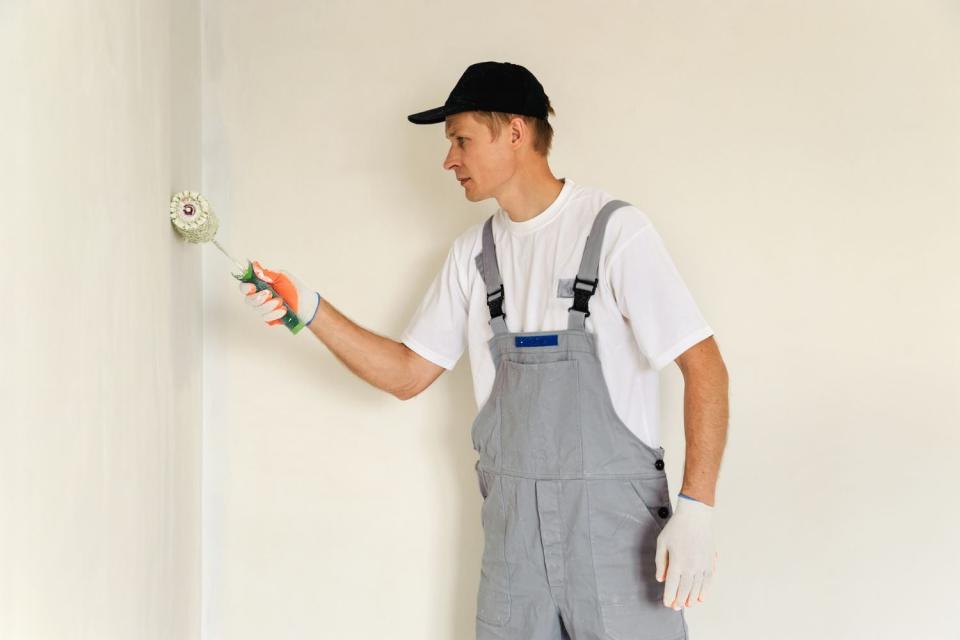
Photo: depositphotos.com
Painting a Ceiling: DIY vs. Hiring a Professional
Taking on a ceiling painting project means homeowners have a choice between taking a DIY approach and hiring a professional. DIY painting can be more budget-friendly, since it avoids labor costs, but painting a ceiling is also physically demanding and technically challenging. Achieving a smooth, professional finish may be difficult for homeowners without prior experience, and painting a ceiling as a DIY project can often take longer to complete than it would for a professional painter.
Professionals have the expertise to deliver a high-quality finish while paying attention to detail. They can also complete the project faster, and they have access to the proper tools and equipment. Many professional painters also offer warranties, providing homeowners with peace of mind regarding the quality of the work.
A DIY approach may be suitable for smaller, straightforward projects where budget constraints are a concern. However, it’s always a good idea for a homeowner to call a professional when the ceiling has intricate designs or custom features or when it requires extensive repairs or texture removal.
How to Save Money on the Cost to Paint a Ceiling
By implementing some money-saving strategies, homeowners can manage the cost to paint a ceiling while maintaining a quality finish.
-
Opt for a light-colored paint. When possible, choose a neutral or lighter ceiling color to use fewer coats of paint.
-
Measure ahead of time. Carefully measure the ceiling area to avoid overbuying paint.
-
Shop around. Compare prices and look for discounts on paint and supplies.
-
DIY repairs. Do necessary repairs and prep work yourself to reduce labor costs before painting.
-
Call for quotes. Get multiple quotes from professional painters to find the best price.
-
Start with primer. Use a primer to ensure better paint coverage, potentially reducing overall paint costs.
-
Combine projects. Bundle the cost to paint a ceiling with the cost to paint a house.
-
Keep up with maintenance. To prolong the ceiling’s lifespan and reduce the frequency of repainting, be attentive to routine maintenance.
Questions to Ask About Painting a Ceiling
When homeowners are hiring a professional painter to paint a ceiling, it’s important to ask questions to ensure a successful and satisfactory project. Homeowners will benefit from a discussion with a professional painter in order to make an informed decision and ensure a smooth and successful ceiling painting project.
Before hiring
-
How many years of experience do you have painting ceilings?
-
Can you provide references or examples of similar ceiling painting projects you’ve completed?
-
Are you licensed and insured to perform painting work in this area?
-
Can you provide proof of liability insurance and workers’ compensation coverage?
-
Can you provide a detailed written estimate, including labor and material costs?
-
Can you provide a written contract that outlines all project details and terms?
-
Are you a member of any professional painting associations or organizations?
-
Do you hold any certifications or training related to painting techniques?
-
What is your payment schedule, and when is payment due?
-
Are there any potential additional charges or hidden fees that I should be aware of?
-
What is your policy for addressing any issues or touch-ups after the project is finished?
-
Do your painters use appropriate safety equipment and follow safety protocols?
About the project
-
How long do you anticipate the ceiling painting project will take?
-
What is your availability, and can you provide a specific start date?
-
What preparation steps will you take before painting the ceiling?
-
Do you handle any necessary repairs, such as patching cracks or addressing water damage?
-
What type of paint do you recommend for the ceiling, and why?
-
Can you assist with selecting an appropriate ceiling color and finish?
-
Do you offer paint samples or swatches for color selection?
-
How do you protect the surrounding areas and furnishings during the painting process?
-
What is your clean-up process upon completing the project?
-
How do you ensure the painter’s safety during the painting project, especially for high ceilings?
-
What is the best way to reach you for updates or questions during the project?
-
How often will you provide progress reports or updates?
-
Do you offer any warranties or guarantees on the quality of your work?
FAQs
Painting a ceiling is a common home improvement project that can breathe new life into a room and even increase the property’s value. Questions often arise when it comes to estimating the cost to paint a ceiling. Below are some of the most frequently asked questions about the cost of the project and valuable insights and guidance to help homeowners budget effectively for the project.
Q. Can you paint a popcorn ceiling?
Yes, a popcorn ceiling can be painted. It’s an excellent way to freshen up the appearance of a room and hide any stains or discoloration. Before painting, it’s important to remove dust, dirt, and any potential contaminants. Any damaged areas must be repaired before painting. Using a good-quality primer is important when homeowners are painting a popcorn ceiling, since the primer helps the paint adhere better and ensures even coverage.
Homeowners are advised to choose a paint that is suitable for textured surfaces. Flat or matte finishes are often recommended for popcorn ceilings, since they can help minimize the appearance of texture irregularities. It’s also important to take safety precautions and wear personal protective equipment, such as safety goggles and a respirator mask, since disturbing the texture can release dust particles. If the texture is disturbed, a pro should be called in to test for asbestos. If it’s found in the ceiling texture, asbestos removal cost ranges from $5 to $20 per square foot.
Q. Do you paint the ceiling or walls first?
The decision to paint a ceiling or wall first can be left up to individual choice; however, it’s often better to paint the ceiling before tackling the walls. Painting the ceiling involves more physical effort, and if it’s left as the final step, there’s a higher chance of drips or splatters that could mar the freshly painted walls. Starting with the ceiling helps homeowners avoid the need for wall touch-ups.
Q. Does a ceiling need two coats of paint?
It’s usually recommended to apply a minimum of two coats of ceiling paint to achieve the best coverage. The number of coats required for ideal coverage depends on the condition of the ceiling, the quality of the paint, and the need for any primer. When homeowners are painting over a darker color with a lighter one, additional paint coats may be necessary.







